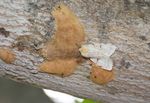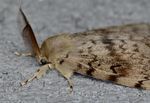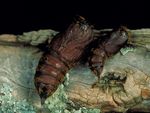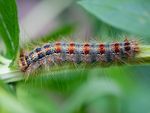EUROPEAN GYPSY MOTH Frequently Asked Questions - Invasive Species Centre
←
→
Page content transcription
If your browser does not render page correctly, please read the page content below
EUROPEAN GYPSY MOTH
Frequently Asked Questions
European gypsy moth (EGM; Lymantria dispar dispar) is
an invasive species from Europe whose caterpillars feed on
the foliage of many hardwood and softwood trees. EGM is
currently established in the northeastern United States and
Eastern Canada.
To learn more about European gypsy moth, visit the Invading
Species Awareness Program or Invasive Species Centre
websites. CATERPILLAR (LARVA)
Q. How often do European gypsy moth outbreaks occur
and why?
A. Spikes in EGM populations happen sporadically and are
caused by environmental and biological factors, such as climate
change and high egg production in favourable weather, that
lead to fast synchronized growth. Rapid EGM population
growth leads to an increase in associated viral and fungal PUPA
pathogens, which usually collapse the population back to low
densities within 1-3 years of outbreak.
Q. What does European gypsy moth look like?
A. You can spot EGM as eggs, caterpillars, pupae, or adult
moths. Egg masses are about 4 cm, tan-coloured, and can be
found on any hard surface – including tree trunks, furniture,
and buildings! Caterpillars are 5-6 cm long and have blue dots
ADULT MALE
and red dots along their backs. Pupa are 3 cm long, brown with
small white/yellow sparse hairs, and can be found in cracks of
trees and building overhangs. Adult moths can be white with
dark markings (females, 5 cm wingspan) or brown with dark
markings (males, 2.5 cm wingspan).
Q. Once European gypsy moth caterpillars transform into
moths, will the moths eat tree leaves?
A. No, adult EGM do not have mouthparts. Caterpillars (larvae) ADULT FEMALE + EGG MASSES
are the stage of EGM that cause defoliation on your trees.
Adult moths use their energy for finding a mate and breeding;
1. ECHOE69, FLICKR; 2. USDA APHIS PPQ, BUGWOOD.
once the females deposit their eggs, they die. The eggs ORG; 3. RYAN HODNETT, WIKIMEDIA COMMONS; 4.
KARLA SALP, WASHINGTON STATE DEPARTMENT OF
overwinter and the cycle resumes the following spring with new AGRICULTURE, BUGWOOD.ORGcaterpillars. Q. Will European gypsy moths kill my tree? A. Not typically for a strong, healthy tree – most deciduous trees can have a “reflush” of leaves later in the summer after the caterpillars are gone. However, it takes a lot of energy for trees to reflush their leaves. Repeated defoliation over several years can make trees more susceptible to other pests and diseases and, eventually, cause mortality. Tree death can also occur if your tree is already weakened or otherwise unhealthy. Keep an eye out for dead branches in your canopy – they can be a safety hazard! Q. How can I manage European gypsy moths on my property? A. There are several easy and effective ways to control EGM populations at home. The first is to target and destroy egg masses by scraping them into a sealable container filled with soap and water. This can be done throughout the fall and winter when the tan egg masses turn a whitish-tan colour and are easier to spot on tree trunks. At the end of collection, dispose of the entire container in the garbage. Another method is to use burlap or a sticky barrier around the trunk of potential host trees to catch caterpillars on their way to the crown (April-June). You can then pick the caterpillars off by hand and destroy them in a container of soapy water. The burlap method can also be used to trap adult females. Q. How can I access hard-to-reach areas high in the canopy? A. In some instances, a ladder or high-pressure hose can help you control caterpillars high in the canopy. You can also consult an arborist or use burlap/sticky bands with insect glue around the base of the trunk – caterpillars will seek refuge at the base of the trunk on hot days! If you are a member of a Property Owners’ Association, having a professional pesticide spray applicator carry out a Btk spray program can be a good choice for reaching the tops of tree canopies. Q. Can I use Btk on my property to control European gypsy moth? A. For private homeowners, Btk (Bacillus thuringiensis kurstaki) is available for purchase from local hardware stores to use against EGM. This biopesticide can be applied by a registered pesticide application company or by homeowners who have carefully read application instructions. Btk is a product that affects the digestive system of caterpillars and should only be applied between May and early June, when EGM are still in the larval (caterpillar) stage. Application of Btk after mid-June is not
an effective way to manage EGM. On a larger scale (multiple properties or a forested area), Btk should only be applied by a professional pesticide application company and is most effective when supported by a team of landowners, landowners’ association, or municipality looking to manage EGM. Q. Will my municipality be spraying for European gypsy moth this year? A. Every area is different! If you would like to know more about your local municipality’s management programs, it is best to contact those forestry departments directly. For examples of EGM community engagement and management at the municipal level, check out the City of London, City of Toronto, Credit Valley Conservation, and City of Hamilton websites. Each province is different as well and plans change annually. For example, in 2020, the province of Ontario did not carry out aerial spray operations for EGM on Crown land. It is best to contact your province directly to learn more about their spray programs. Q. Is Btk harmful to me or other organisms? A. Btk is a naturally-occurring bacteria that affects the digestive systems of caterpillars. Since Btk does not specifically target EGM, there are some native caterpillars that will be affected by aerial spray operations. Btk is not harmful to humans or other wildlife as it is a bacteria only found in insects. Q. I’m worried about the forest next door. What can we do? Who owns the land? A. In this case, it’s best to connect with the conservation authority for the region you reside in. Conservation authorities typically have access to comprehensive mapping software and may be able to assist with determining property ownership and OPUNTIA, WIKIMEDIA COMMONS the process for management. If you think you’ve seen European gypsy moth, report your sighting to 1-800-563-7711, www.eddmaps.org/Ontario (Ontario), or www.invasivespeciescentre.ca/report-a- sighting (Canada-wide). Reporting invasive species helps us to better understand current distribution and long-term trends, and is especially important if the sighting is outside of regulated areas.
You can also read
























































